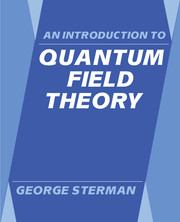Book contents
9 - Loops, regularization and unitarity
Published online by Cambridge University Press: 05 August 2012
Summary
Loops are the characteristic feature of higher orders in the perturbative expansion of Green functions. In principle, loop diagrams are completely defined by the same Feynman rules that give tree diagrams; the only difference is that there are integrals left to do. In practice, the evaluation of these integrals is not completely straightforward. First, their integrands diverge at propagator poles. The integrals remain well defined, however, because of the infinitesimal term ‘i∊’ in each propagator. We shall show below how this works, and how the ‘i∊-prescription’ defines Green functions as analytic functions of their external momenta. Second, in most field theories, some integrands simply do not fall off fast enough at infinity for the corresponding integrals to converge. Such integrals are said to be ultraviolet divergent. The consideration of this problem will lead us, in due course, to the concepts of regularization and renormalization.
We begin our discussion with a simple example, which will illustrate both of these problems. Later in the chapter, we develop the method of time-ordered perturbation theory, and use it to verify that the perturbation expansion generates a unitary S-matrix order-by-order in perturbation theory. Unitarity is a fundamental property, necessary for a theory to make physical sense.
- Type
- Chapter
- Information
- An Introduction to Quantum Field Theory , pp. 247 - 279Publisher: Cambridge University PressPrint publication year: 1993



